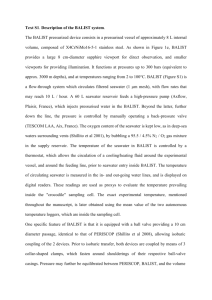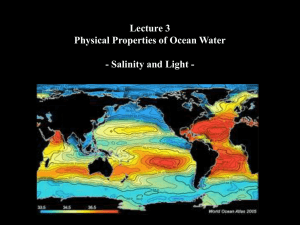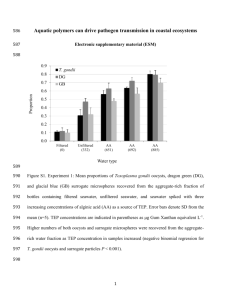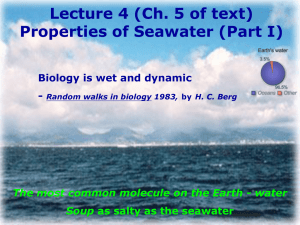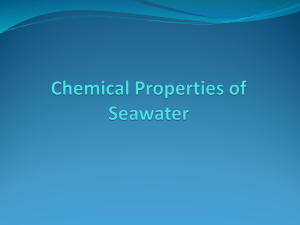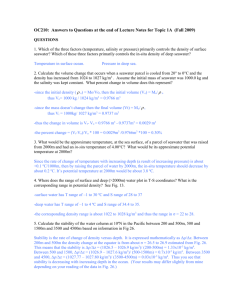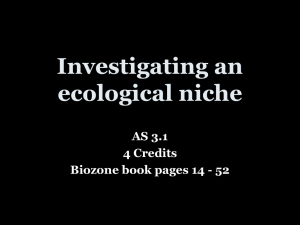sussher et al AMT Fe 2012 auxiliary material text01
advertisement
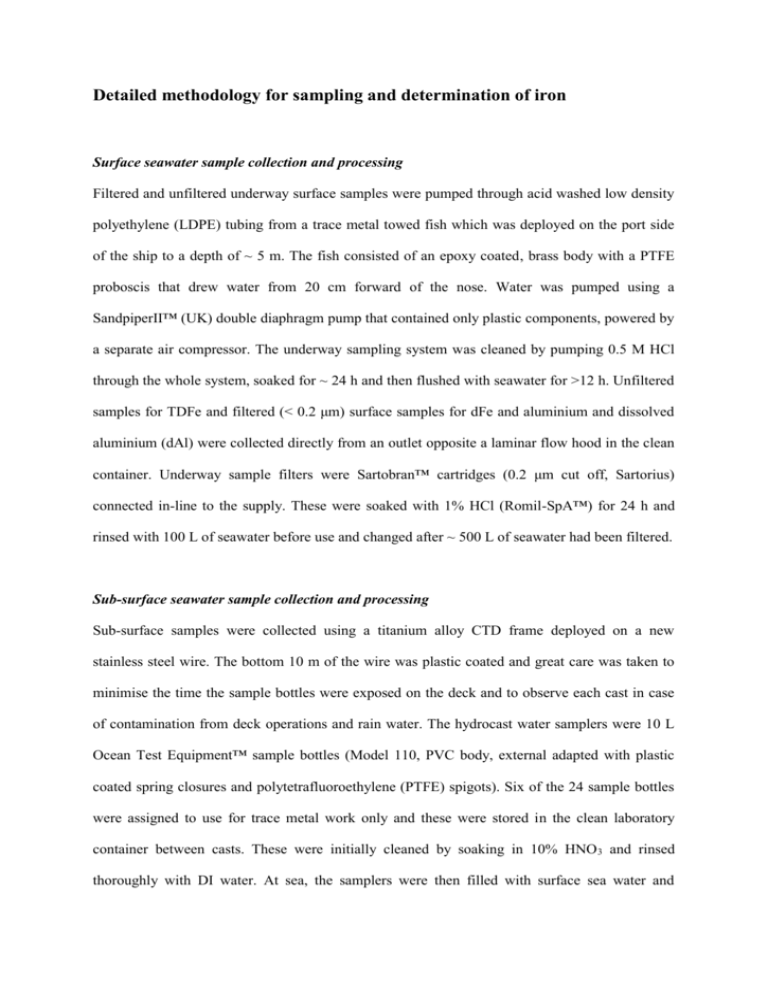
Detailed methodology for sampling and determination of iron Surface seawater sample collection and processing Filtered and unfiltered underway surface samples were pumped through acid washed low density polyethylene (LDPE) tubing from a trace metal towed fish which was deployed on the port side of the ship to a depth of ~ 5 m. The fish consisted of an epoxy coated, brass body with a PTFE proboscis that drew water from 20 cm forward of the nose. Water was pumped using a SandpiperII™ (UK) double diaphragm pump that contained only plastic components, powered by a separate air compressor. The underway sampling system was cleaned by pumping 0.5 M HCl through the whole system, soaked for ~ 24 h and then flushed with seawater for >12 h. Unfiltered samples for TDFe and filtered (< 0.2 μm) surface samples for dFe and aluminium and dissolved aluminium (dAl) were collected directly from an outlet opposite a laminar flow hood in the clean container. Underway sample filters were Sartobran™ cartridges (0.2 μm cut off, Sartorius) connected in-line to the supply. These were soaked with 1% HCl (Romil-SpA™) for 24 h and rinsed with 100 L of seawater before use and changed after ~ 500 L of seawater had been filtered. Sub-surface seawater sample collection and processing Sub-surface samples were collected using a titanium alloy CTD frame deployed on a new stainless steel wire. The bottom 10 m of the wire was plastic coated and great care was taken to minimise the time the sample bottles were exposed on the deck and to observe each cast in case of contamination from deck operations and rain water. The hydrocast water samplers were 10 L Ocean Test Equipment™ sample bottles (Model 110, PVC body, external adapted with plastic coated spring closures and polytetrafluoroethylene (PTFE) spigots). Six of the 24 sample bottles were assigned to use for trace metal work only and these were stored in the clean laboratory container between casts. These were initially cleaned by soaking in 10% HNO 3 and rinsed thoroughly with DI water. At sea, the samplers were then filled with surface sea water and acidified with HCl (final concentration 1%, Aristar™ Grade, VWR), soaked for ~12-14 h and finally rinsed inside and out with DI water. Between CTD casts, samplers were stored opposite a laminar flow hood in a clean container. Generally, no obvious sources of contamination were detected and mixed layer concentrations for samples collected underway and during the casts compared well. Bottle leakages were checked regularly with salinity and nutrient measurements. The filters used for cast samples for dFe and dAl were 0.2 μm pore size, PTFE membrane syringe filters (GD/X ™, Whatman) The filters were connected to a peristaltic pump (8-channel, Minipuls2™, Gilson, France) using PTFE tubing (0.8 mm I.D., Fisher, UK) and were cleaned by first activating the membrane with 2 mL of methanol (SpA™ grade, Romil, UK), followed by soaking in 1 M HCl (SpA™ grade, Romil, UK) for 4 h and rinsed with >50 mL of DI water. The filters were finally conditioned with 20 mL of sample seawater before collection was made For sample filtration, 250 mL aliquots were collected in LPDE bottles (stored in 1% HCl and rinsed before use) from the 10 L samplers and transferred to the laminar flow hood. Six samples were then simultaneously filtered by pumping at 1.5 mL min -1 through the pre-washed syringe filters. Before sample collection in 30 mL LDPE sample bottles, 30 mL of each sample was collected and used as a final rinse for the filters and the sample bottles. Selected sub-samples of filtered surface water (0.2 μm cut off) were collected for sFe and were filtered again at a flow rate of ca. 1 mL min-1 through pre-cleaned Anotop™ syringe filters (25 mm, 0.02 µm pore size, Whatman) connected in-line to a 6-channel peristaltic pump (Gilson Minipuls 3™). The filters and the peristaltic pump tubing (Elkay) and PTFE tubing (1/32” ID, Cole Palmer) used to transfer the sample were cleaned before use with 0.01 M HCl (20 min) and DI water (1 h) and then conditioned with seawater sample (20 min). After each filtration, the lines were rinsed with 1M HCl followed by DI water and the filters were replaced. Determination of iron species in seawater Iron in size fractionated seawater samples (sFe dFe and TDFe) was determined using flow injection with chemiluminescence detection (FI-CL). This used luminol as the chemiluminescence reagent and employed a sulfite reduction step (spiked addition of sodium sulfite to make a final concentration of 0.1 mM, 12 h reaction time) prior to determination of Fe(II) [Bowie et al., 1998]. A 20.0 mM ammonium iron(II) sulphate (hexahydrate, 99.997%, Sigma) stock standard solution was made weekly in 0.1 M HCl and working standards were made daily from this standard. Calibrations were performed daily by standard additions of a 0.200 µM Fe(II) standard (pH 3.0) to an acidified surface seawater sample taken from the same region as the batch of samples analysed on that day. The blank subtractions were the sum of the blanks of all reagents added to the sample. These included the injection blank (from the flow injection analyser), an acid blank (iron in bottles stored filled with DI water at pH 1.9) and a sulfite blank. The injection blank was defined as the mean of four replicate analyses, where the sample line of the FI-CL manifold was closed and the pump tubing removed from the peristaltic pump, hence only residual Fe(II) in the FI system (including buffers and rinsing) was measured. The acid blank included the storage (or sample bottle) blank and was determined by spiking two bottles containing DI water with HCl (ROMIL™, UpA) to make 0.005 and 0.015 M concentrations and doing standard additions to determine dFe in each. Typically the acid blank was negligible (< ca. 25 pM) and hence only the contribution from the bottle was considered (i.e. the analytical signal itself rather than the difference between the two solutions). The sulfite blank was assessed daily by analysing 0.1 mM (concentration used for reduction of Fe(III)) and 0.3 mM solutions of sodium sulfite (SigmaUltra™ grade, Sigma). Typically the difference between the signal of the two solutions was negligible (< 12 pM) as the sulfite had been cleaned through a 10 cm column containing 8- hydroxyquinoline (8-HQ) resin. The between batch consistency of dFe analysis and the within batch drift was checked by analysing the IRONAGES reference seawater [Bowie et al., 2006] and an in-house reference seawater with each batch of samples. Analysis of SAFe S1 and D2 seawater reference materials gave 0.18 ± 0.02 nM and 0.93 ±0.04 nM, respectively (consensus values were 0.097 ±0.043 nM and 0.91 ±0.17 nM, respectively [Johnson et al., 2007]). Two blind intercomparisons with an ICP-MS method were also performed using Atlantic open ocean and shelf samples and gave good agreement within the range 0.2-2.0 nM [Bowie et al., 2007; Ussher et al., 2010]. References Bowie, A. R., E. P. Achterberg, R. F. C. Mantoura, and P. J. Worsfold (1998), Determination of sub-nanomolar levels of iron in seawater using flow injection with chemiluminescence detection, Analytica Chimica Acta, 361(3), 189-200. Bowie, A. R., E. P. Achterberg, P. L. Croot, H. J. W. de Baar, P. Laan, J. W. Moffett, S. Ussher, and P. J. Worsfold (2006), A community-wide intercomparison exercise for the determination of dissolved iron in seawater, Mar. Chem., 98(1), 81-99. Bowie, A. R., S. J. Ussher, W. M. Landing, and P. J. Worsfold (2007), Intercomparison between FI-CL and ICP-MS for the determination of dissolved iron in Atlantic seawater, Environmental Chemistry, 4(1), 1-4. Johnson, K. S., et al. (2007), Developing standards for dissolved iron in seawater, Eos Trans. AGU, 88(11), 131. Ussher, S. J., I. Petrov, C. R. Quétel, and P. J. Worsfold (2010), Validation of a portable flow injection–chemiluminescence (FI-CL) method for the determination of dissolved iron in Atlantic open ocean and shelf waters by comparison with isotope dilution–inductively coupled plasma mass spectrometry (ID-ICPMS), Environmental Chemistry, 7(2), 139-145.

